1lumen selects and reviews products personally. We may earn affiliate commissions through our links, which help support our testing.
Imalent R30C review

Imalent R30C specifications
| Brand/model | Imalent R30C |
|---|---|
| LED | Luminus SST70 |
| Lumens | 9,000 lm |
| Beam intensity | 78,960 cd |
| Battery config. | 1*21700 |
| Material | Aluminum |
| Modes | 6 |
| Blinkies | Strobe |
| Reflector | Smooth |
| Waterproof | IPX8 |
| Review date | March 2021 |
Introduction:
Ask any flashlight enthusiast who makes the brightest, craziest flashlights and one brand sticks out: Imalent. In fact, they are credited with making some of the brightest flashlights around, including the Imalent MS18, which is currently the brightest production flashlight at 100,000 lumens (albeit for about half a second). Although most known for the MS18, Imalent also produces high-performance EDC lights, long-range throwers, and recently the UT10 Ranger weapon light. However, even their “practical” flashlights are a little bonkers. Enter the all new R30C. This is a compact triple LED light claiming 9,000 lumens and almost 600 meters of throw. Those specs aren’t that remarkable considering some of the high-performance lights we are getting these days, but consider the R30C’s dimensions: under 5 inches long, 40 mm head, and takes a single 21700 battery. Seriously, would you expect anything less from Imalent? Let’s take a look
Package quality.
Nice packaging at this price point is obligatory, and I wasn’t disappointed. The packaging is a nice black-on-black color scheme with a near lifesize image of the R30C front and center and metallic embossed font. The boxtop flips open lengthwise and have a magnetic closure on the end (reminds me of Olight’s packaging). Inside the R30C is nicely protected in foam next to a box containing the accessories.
What You’ll Get:
- The Imalent R30C
- 2 spare o-rings
- Lanyard
- Multilingual manual
- Holster
- USB A to type C charging cable
- Imalent 4000 mAh 21700 with USB C charging (loaded in the tube)
This kit has everything you need to get going, and I’m glad they included a decent quality hoster. However, the included USB cable was faulty, which was annoying because you need it to charge the battery. Good quality USB cables are cheap so this is a bit inexcusable.
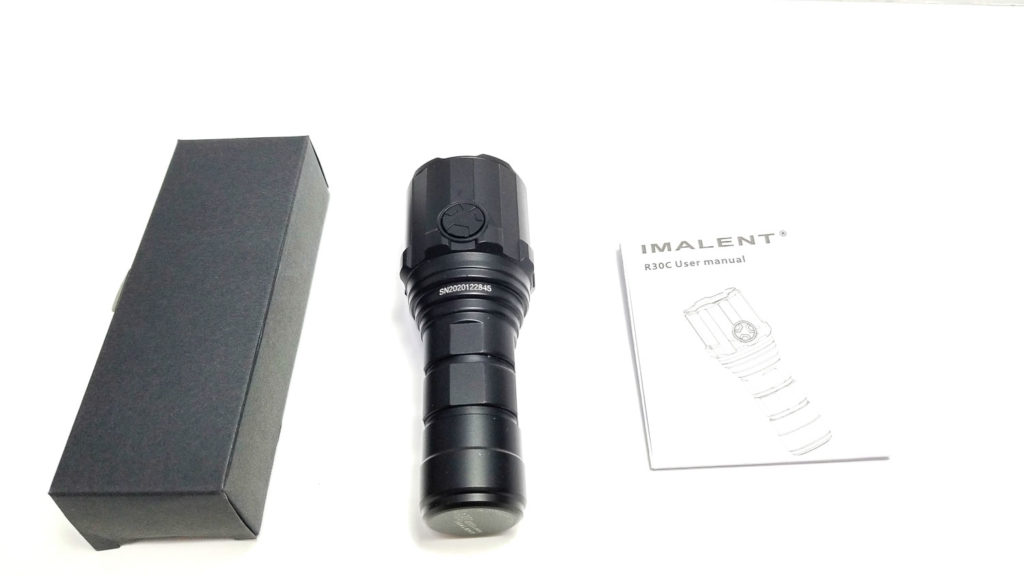
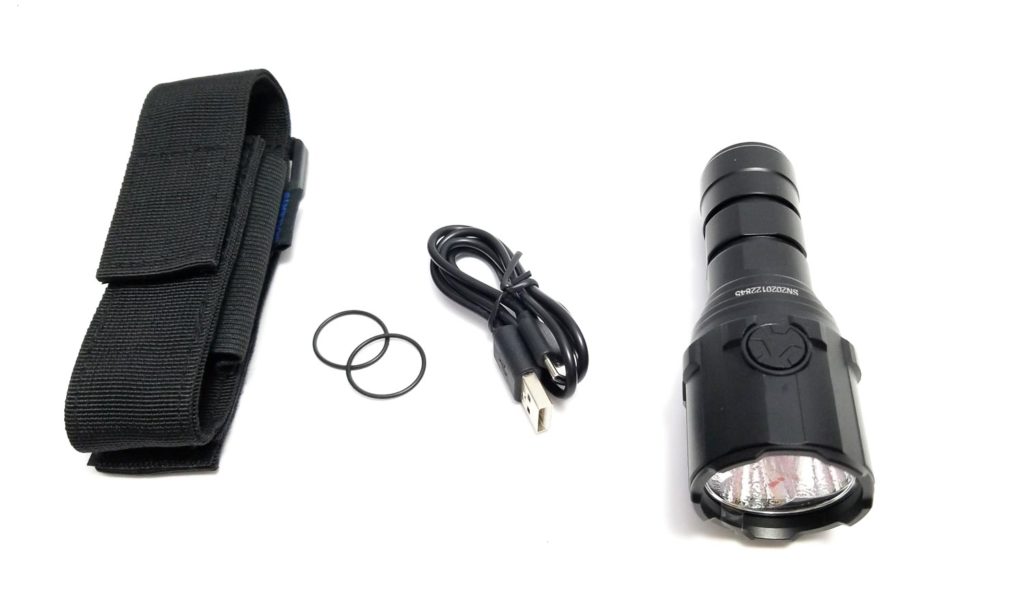
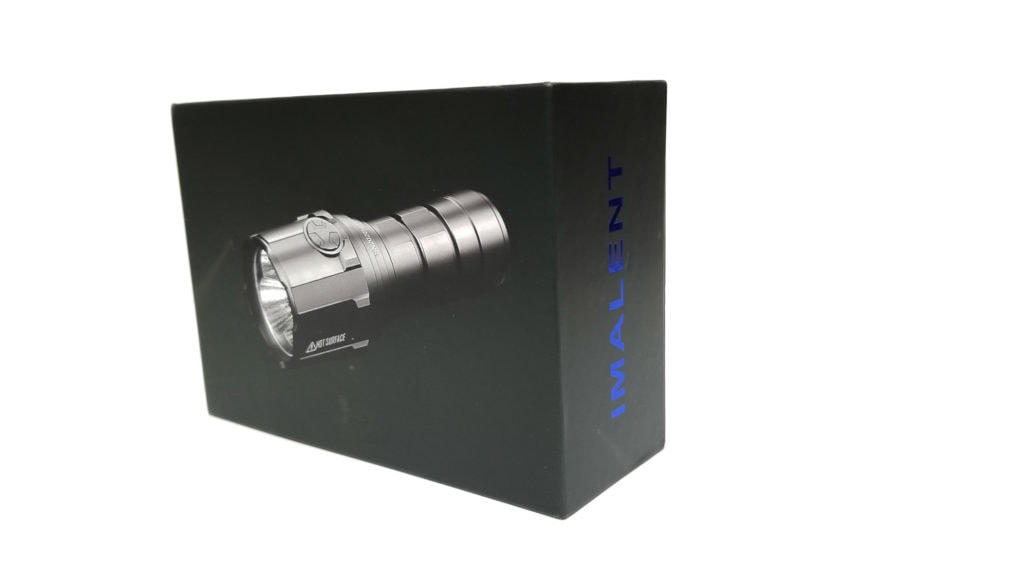
Flashlight in use
The R30C is the shrunk down version of the larger 6 LED Imalent R60C, and this thing is very compact. The size is close to the Imalent MS03 that Owen reviewed last year. I like the ergonomics and it balances nicely in the hand. The electronic side switch is a large metal button with an interesting pattern, but it’s pretty flush with the head, and wasn’t that easy to find by feel. I didn’t see any indicator lights to help with that. The switch button cover was also loose and rattled around, which made the click action feel vague and cheap. This is definitely out of place on a light in this price range and detracted from the overall quality feel.
The R30C is small enough to fit in the palm of my hand, and it would be easy to carry in a jacket or cargo pocket. It’s kind of hefty for EDC though at almost 9 ounces with the battery. The body, although lacking knurling, has circumferential grooves cut in the battery tube that help with grip. I didn’t feel like I had any trouble handling the R30C, but regular knurling or texturing would have been welcome. Thankfully tail standing is not an issue. The head design prevents it from rolling around, but oddly there’s no lanyard hole. I’ve come to realize that a lanyard hole is one of those things that’s nice to have and not need, then need and not have.
The holster works fine for bezel up carry and seems to be good quality with a stout Velcro belt loop and plastic retention ring for clipping to a carabiner.
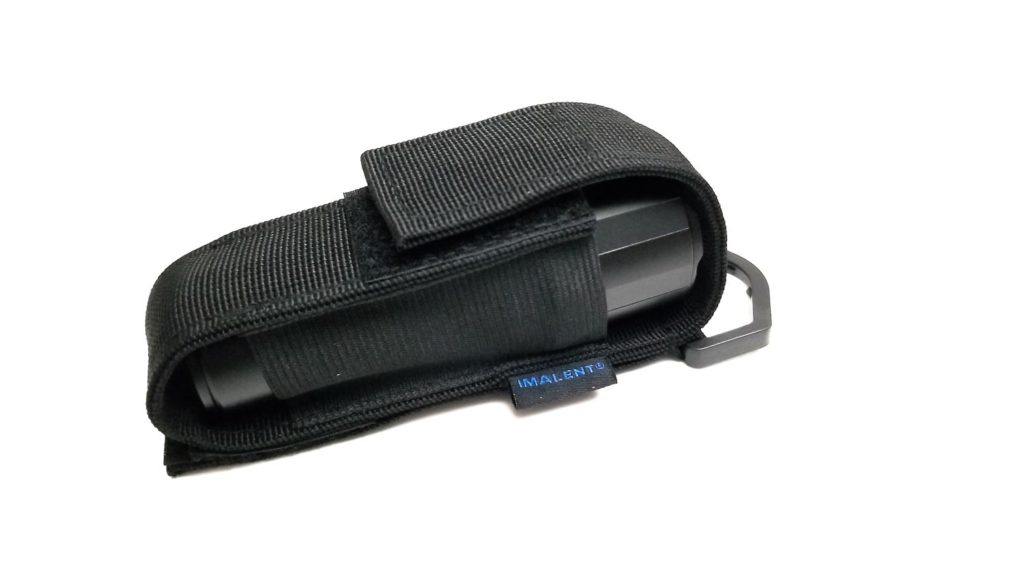
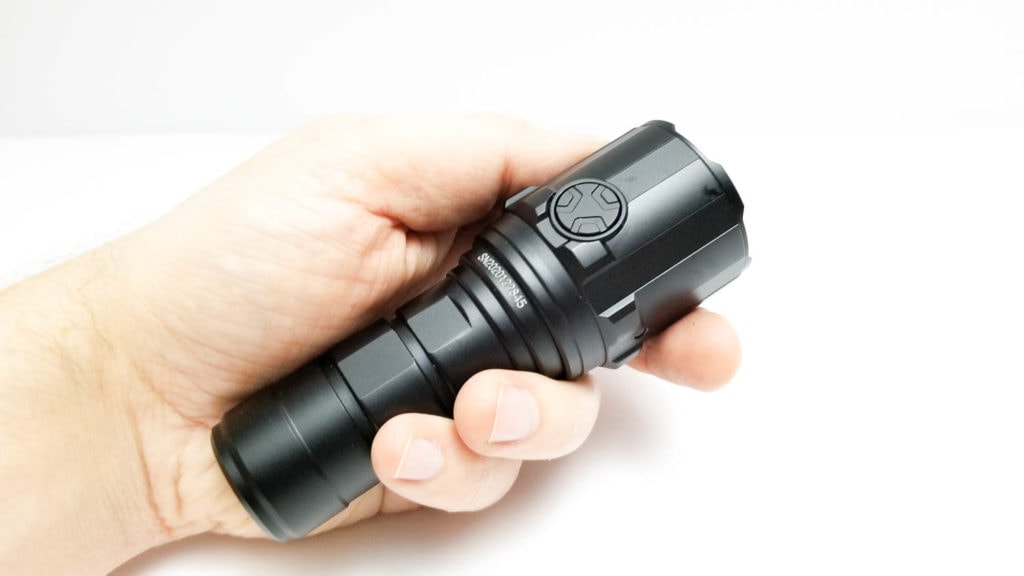
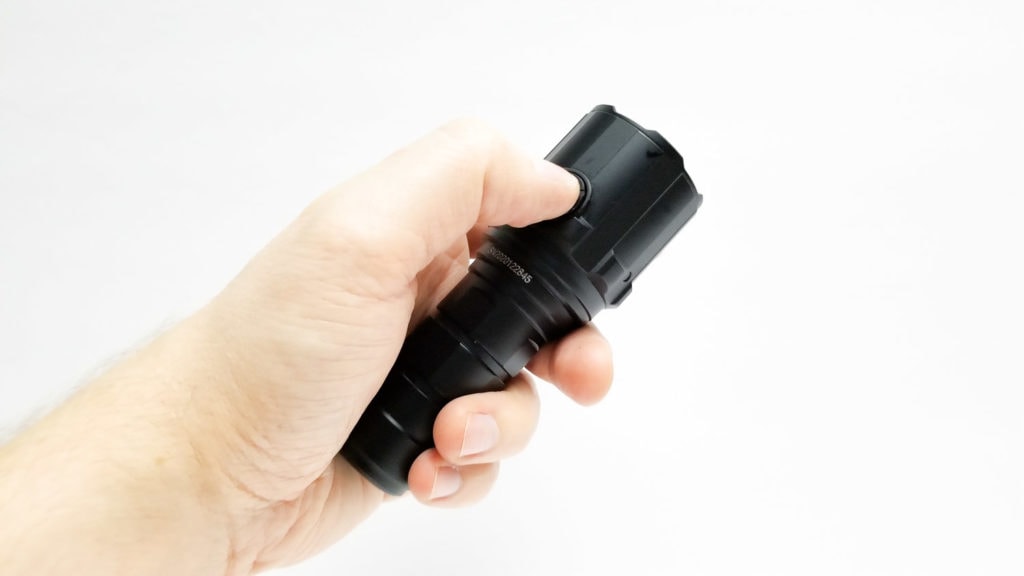
Build Quality, and Warranty
This is my first hands-on with an Imalent light, and overall I’m pleased with the build quality. It feels like a quality item, and there’s a robust warranty backing it. Imalent gives you a 15 day return policy for defects, 5 year (60 month) warranty for free repairs, and a lifetime limited warranty. After 5 years, they charge for parts or accessories needed for repair.
All the parts fit together fine, and the machining is perfect with no sharp edges, blemishes, or tool marks anywhere. The blacked-out finish looks great. It’s a semi-gloss type III hard anodizing and I didn’t see any issues with coverage or thin areas. The only glaring fault is that the aforementioned side switch felt cheesy and cheap. The silkscreening text isn’t the sharpest either.
Interestingly, there are no heat sinking fins. Perhaps Imalent made up for that in extra mass? This is peculiar since a great way to dissipate heat is to increase the mass and surface area, which fins help with.
Out back, unscrewing the tailcap revealed a good-sized single o-ring with very beefy fully anodized square cut threads. They had plenty of lube out of the box as well and were super smooth. The single gold-plated tailspring is pressed into the tailcap and is sufficiently thick, but I was expecting a dual spring design. If this light performs how I think it will, that spring is going to heat up a bit.
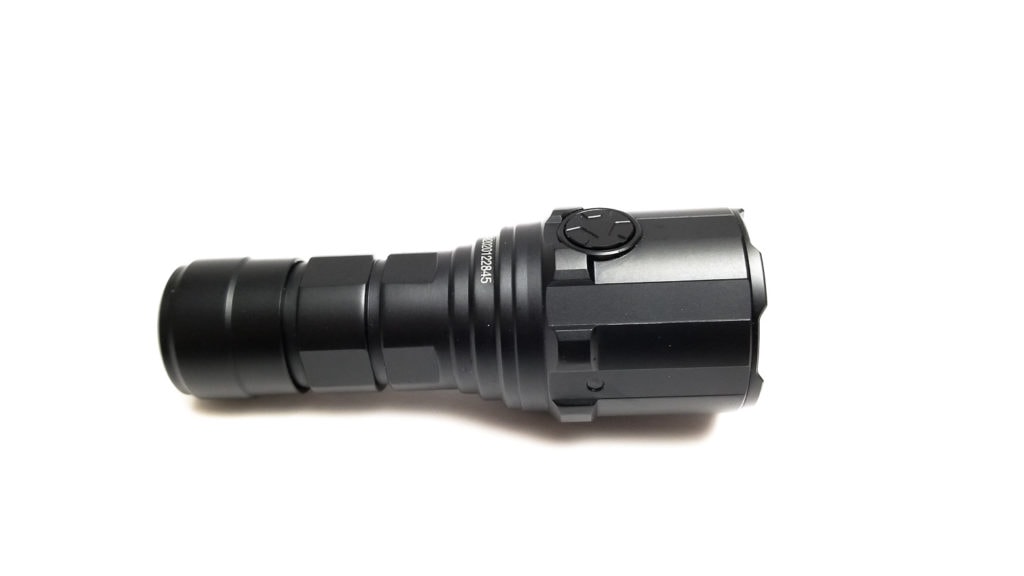
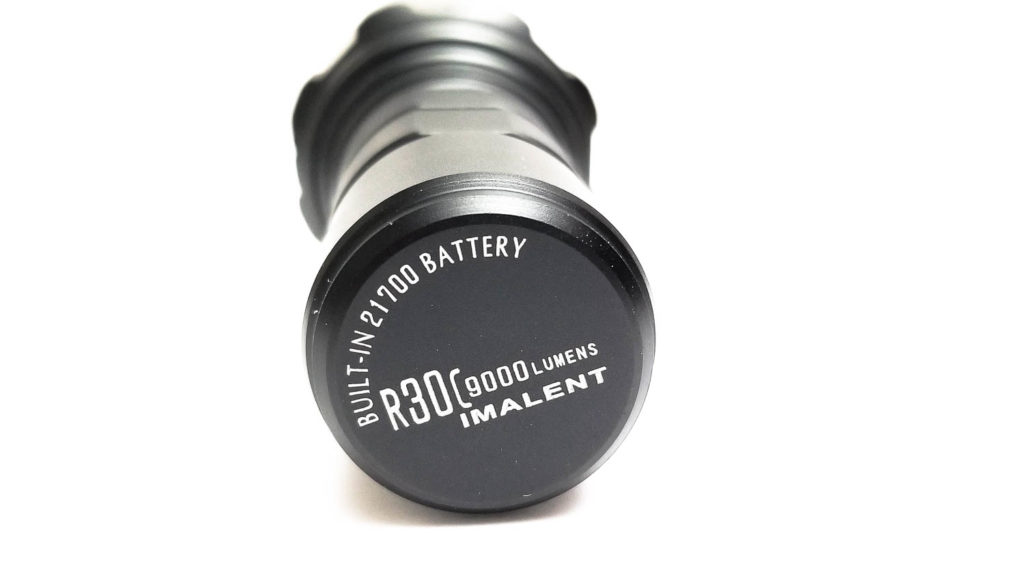
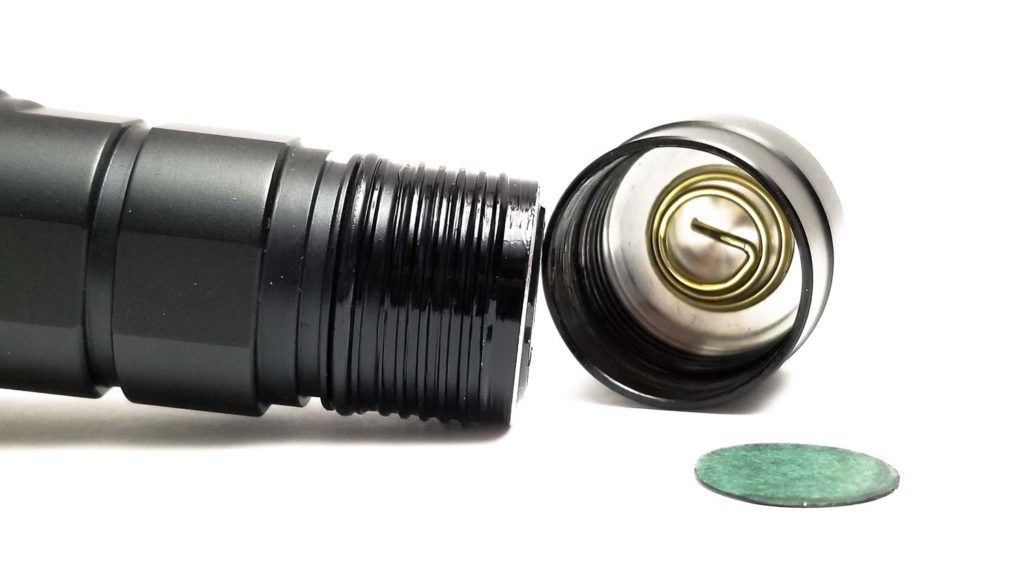
LED, Lens, Bezel, and Reflector
The R30C features a triple emitter arrangement, and once again we have another flashlight manufacturer refusing to divulge the make and model of the LEDs. Imalent is calling these “American LEDs,” but keen-eyed readers will identify them as the ubiquitous Luminus SST70.
The SST70 is a quad die LED with the same footprint as the Cree XHP50.2 and Luminus’s own SST40. It’s 6 or 12 volt compatible and the light emitting surface is around 55% smaller than the 50.2. This equates to similar output compared to the 50.2, but more throw and no corona or tint shift. The only advantages of the 50.2 is you can get it in 3 volts and much higher potential output. Speaking of tint, you can have any color you want as long as it’s cool white, 6500 to 7000k.
The LEDs are perfectly centered in the OP reflector (Imalent advertised it as SMO), which is protected by a mineral glass lens with AR coating. The blacked-out bezel is conservatively crenulated and seems glued on, so no modding unless you feel like attacking it with a heat gun and wrenches.
This is predominantly a flooder. Although Imalent advertises 560 meters of throw, this seems very optimistic from a small OP reflector, but surprisingly the throw is decent. There is a visibly diffuse medium size hotspot with a smooth transition from hotspot to spill. I did notice the beam is slightly green (like some SST40’s I’ve seen) on the white wall in low mode, but immediately goes away as you increase brightness. Although I like more neutral white CCT’s, the R30C beam isn’t obtrusive at all with just nice white light on higher settings.
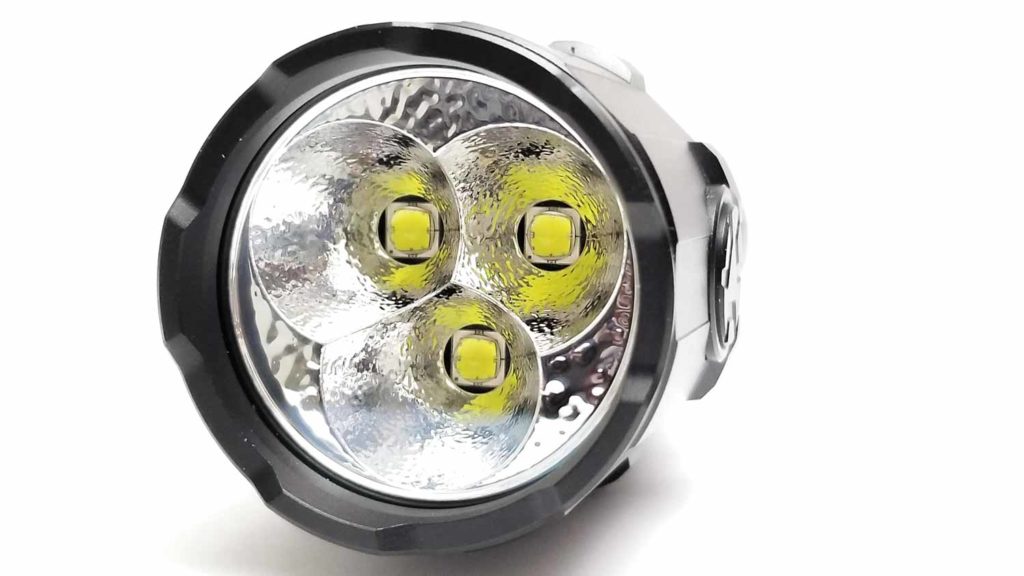
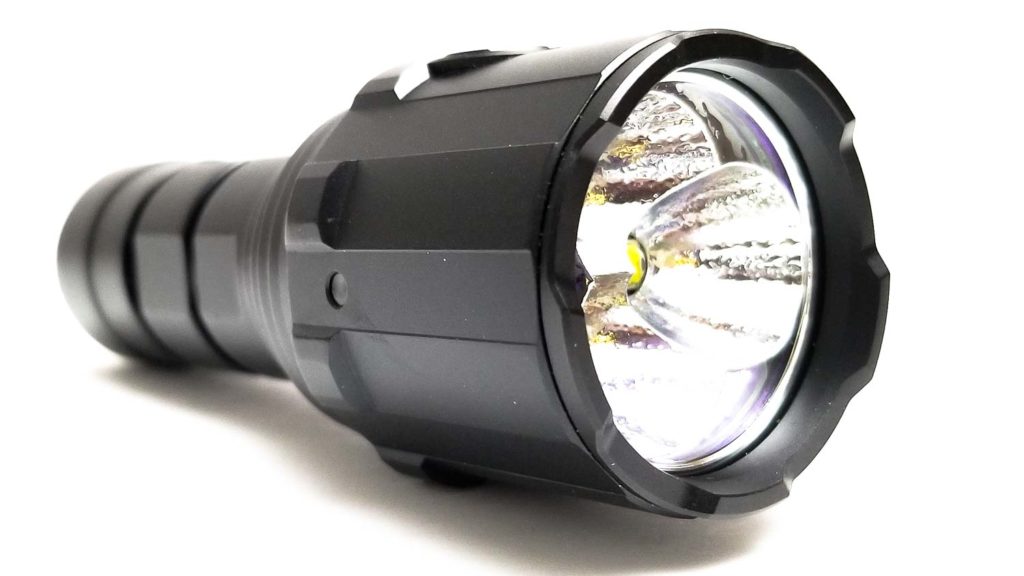
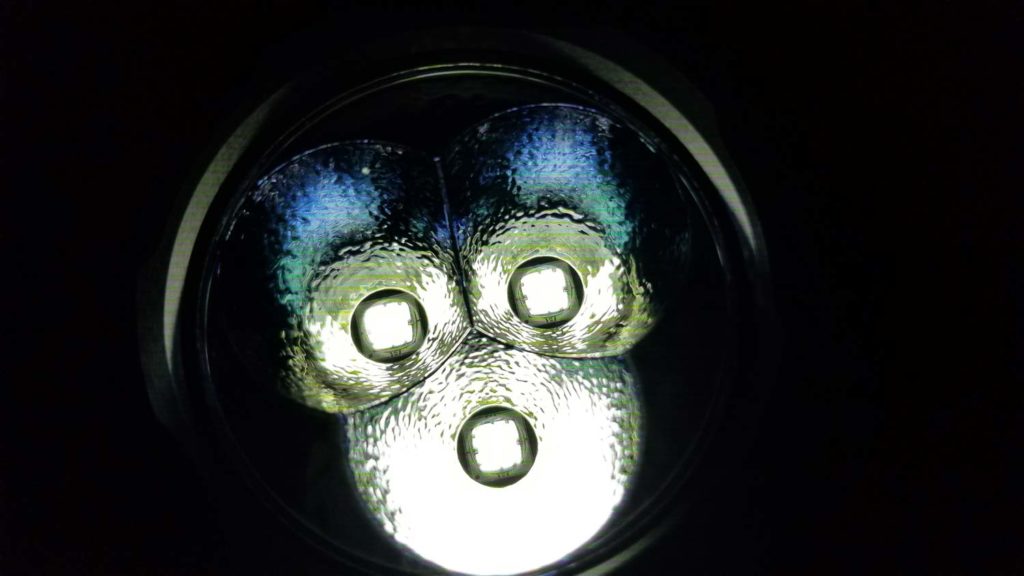
Dimensions and size comparison
- Length: 115 mm / 4.52 inches
- Head diameter: 42 mm / 1.65 inches
- Body diameter: 29 mm / 1.14 inches
Weight:
- With battery (my measurements): 237.7 gr. / 8.38 oz. Without battery: 166.4 gr. / 5.88 oz.
Flashlight Size comparison
Group 1 left to right: Sofirn SP10S, Imalent R30C, Astrolux EC03, Thorfire C8
Group 2: Imalent R30C, Astrolux FT02S.
As you can see, the R30C is quite a bit smaller than the FT02S and even a bit smaller than the C8.It is chunky though, weighing in at almost 9 ounces loaded.
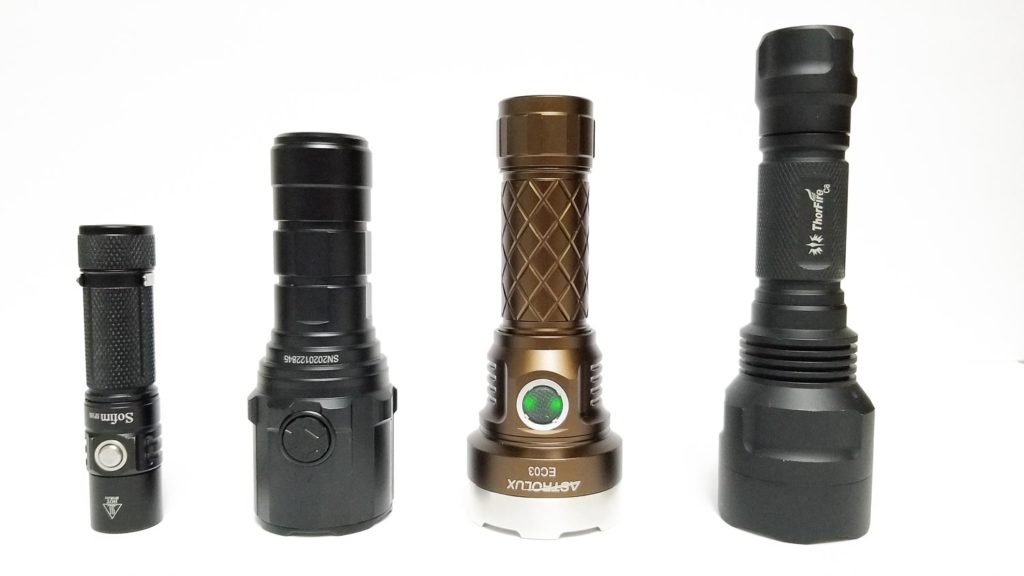
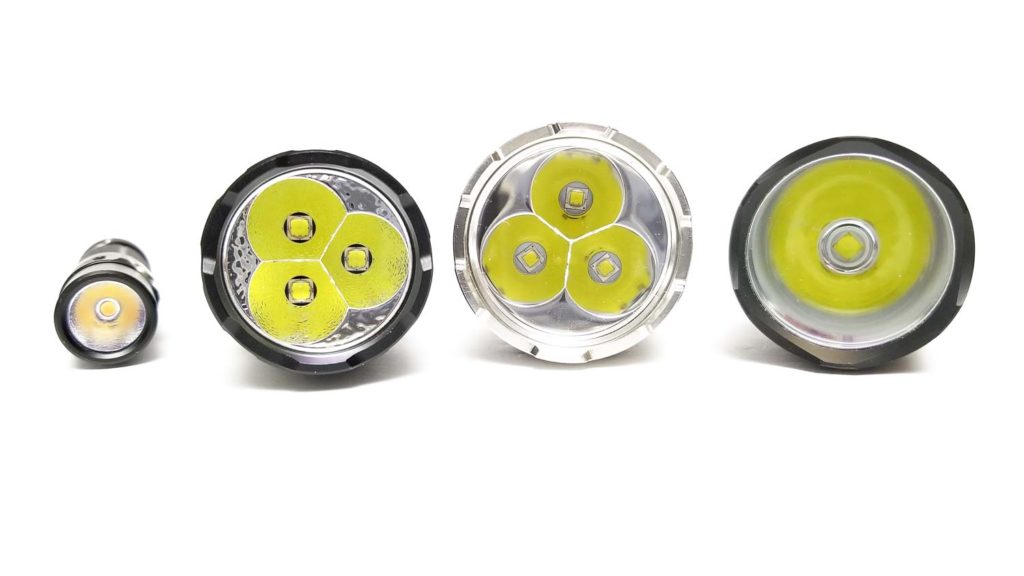
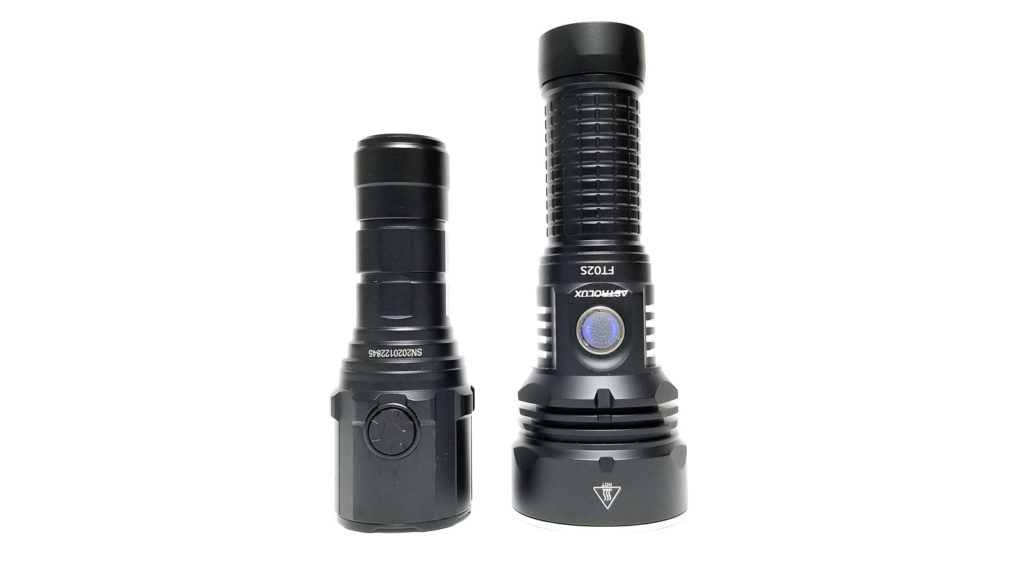
Driver & User Interface:
Imalent uses a simple UI for the R30C, which is fine with me. No mode menus, no thermal configuring or calibrating. It’s one click on and one-click off with 5 modes plus turbo and a single strobe. To cycle through the modes, click once to turn on, then hold to cycle through low, middle low, middle 1, middle 2, and high. Turbo is accessible at any time with a double click, and there is a single strobe mode accessed with double click when in turbo. The driver is most likely a boost diver to step up the 4.2 volts to 6 volts and has thermal regulation, set to start throttling at 55 C.
From OFF:
- Single-click: On in last memorized mode
- Double click: Turbo
- Triple click: On in low mode
- Press and hold: For 2-3 seconds toggles indicator lights on or off
- 4 clicks: Lockout
From ON:
- Press and hold: Cycles through the modes
- Single click: Off
- Double click: Turbo
- Triple click: N/A
- 4 clicks: N/A
Mode memory:
- Yes, last mode memory. Turbo and strobe are not memorized.
Low voltage warning:
- Yes. There are 2 indicator lights on the side of the head opposite each other that are green when the battery is more than 3.0 volts, and turn red and start blinking when 3 volts or less. The light shut off when the battery was around 2.8 volts under load. However, it’s abrupt and there’s not really any warning other than the indicators.
Strobe/blinkies
- Yes, single strobe
Lock-out mode:
- Yes accessed with 4 clicks from off. 4 clicks to unlock.
PWM
- There is PWM in all modes, but it’s fast PWM and I can only see it with my cell phone camera.
Add additional info: The UI is simple and easy to learn and use. The mode cycling is slow, with a 2 second pause in between the mode change. I would have liked it to be a bit quicker. There’s no moonlight mode, and at 150 lumens, low mode is hardly low. The battery indicator lights can be configured as switch lights that shine continuously to help find the light in the dark. Trouble is, they are not on or even adjacent to the switch, so they aren’t too useful for that. The electronic lockout is activated by clicking 4 times from off. The indicator light will flash green twice to confirm the lockout, and will blink when you try to turn it on. To deactivate, click 4 more times. The light can also be locked out by unscrewing the tailcap slightly. Another feature is you cannot activate turbo if the battery is under 3.8 volts or the temperature is over 65 C.
First off, don’t believe the writing on the tailcap since this battery is not built-in! The light comes with Imalent’s MRB-217P40 21700 cell. This looks like the same cell the MS03 uses. It’s rated at 4000 mAh with built-in USB type C charging and a pretty robust protection circuit.
This is a proprietary cell, which means you are stuck with using this battery in the R30C. In addition, there are interference bars on the back of the driver to keep you from using flat top cells (and for reverse polarity protection), and the 21700 button tops I tried didn’t work either.
As annoying as this is for enthusiasts, for the rest of us, proprietary batteries aren’t a bad thing because they ensure the light meets the factory performance specifications and prevents the light (and user) from being damaged by using improper batteries (or putting in them in backwards). Moreover, it’s not all doom and gloom since I suspect there’s a Samsung 40T under the wrapper, and Imalent warranties the battery for 1 year.
The cell came pre-charged to 4 volts, which is not the greatest voltage for long-term storage. The built-in charging circuit specifies a 2 amp charge current and when I tested that with my Eversame USB tester using a 2.1 amp wall charger, I got around 1.5 amps. That seems low, but it makes sense due to losses in the buck circuit that steps down 5 volts to 4.2 volts the battery needs, so in reality, it’s closer to 2 amps. It would take about 3.5 hours to fully charge the cell, which isn’t fast charging, but not terrible. I don’t own a charger big enough for protected 21700’s, don’t I know if you could charge this battery in a regular charger, so try at your own risk.
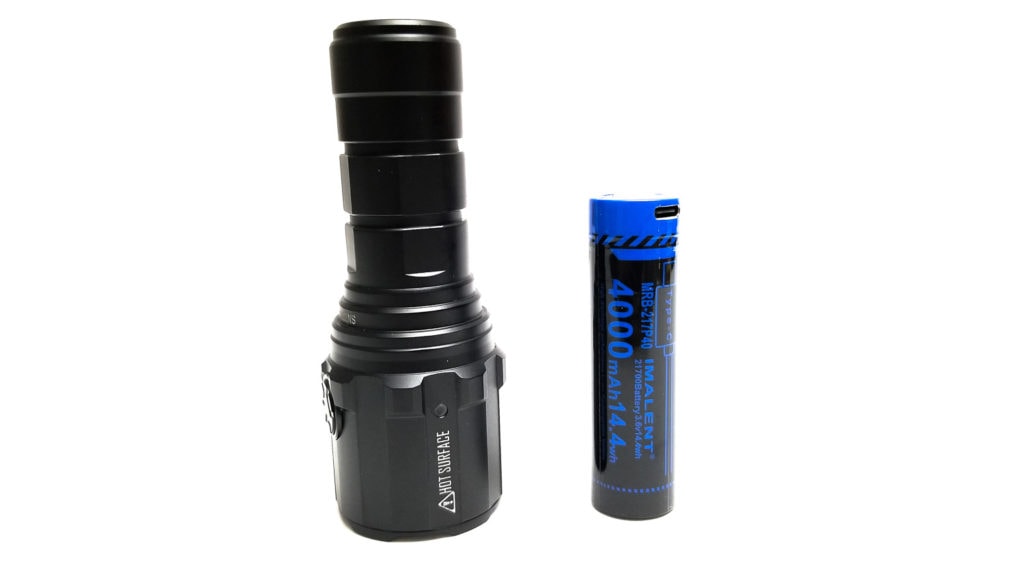
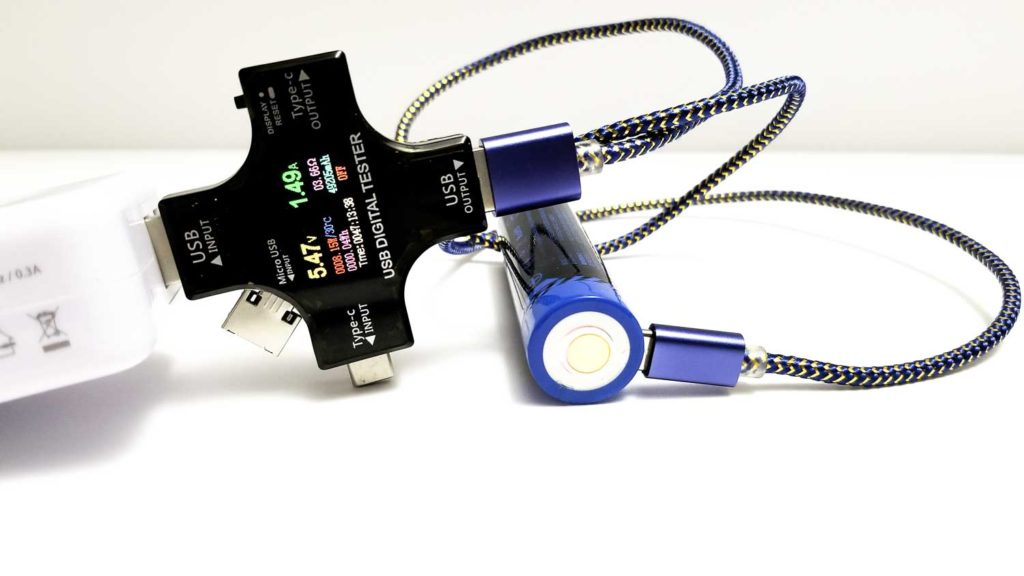
Performance
Time to see if the R30C is worthy of the Imalent nameplate. It will be interesting to see how it handles the heat since a small light with this much power (around 180 watts on turbo) running through it will heat up fast.
Amp measurement
For the current measurement, I used my Radio Shack T-RMS multimeter with short 16 gauge wires inserted directly into the meter for lower modes and my clamp meter for the higher modes over 8 amps.
There is parasitic drain, which I measured at 0.22 mA. With the switch indicators on that went up to 2 mA. With a fully charged battery that’s about 1,900 standby hours or around 80 days.
For the current draw test, I captured the 30 second measurement for all modes, as well as the turn-on for high and turbo.
- Low: 207 mA
- Middle low: 1.12 A
- Middle 1: 2.78 A
- Middle 2: 5.58 A
- High: 19.15 A (at turn on) 13.7 A at 30 sec.
- Turbo: 31 A (at turn on) 4 A at 30 sec.
Runtime graph
Testing was conducted using the 30 cm integrating sphere calibrated with a light of known output and the Digi-Sense 20250-00 data logging lux meter. Temperatures were measured with my Ames non-contact thermometer.
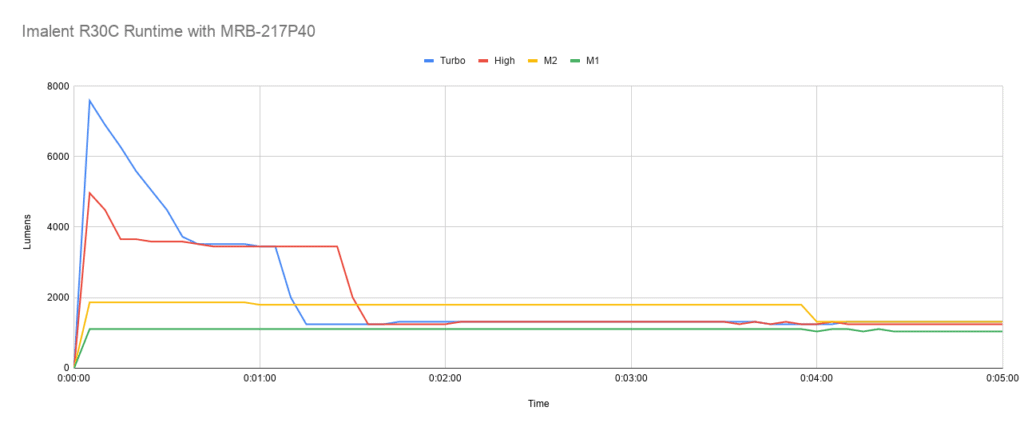
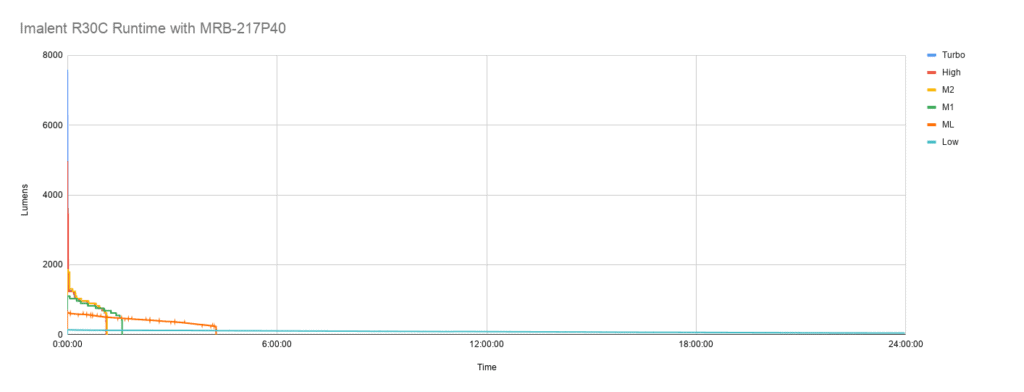
Imalent specified 20 hours for the low mode runtime, but I got well over that. I ended the test at 24 hours after the 20 hour mark came and went and the output had hardly dropped. The output was remarkably steady and flat, indicative of a boost driver.
Middle low ran for 4 hours 15 minutes, which again is over Imalent’s figure of 3 hours and 40 minutes. There were metered step downs every 10 to 20 minutes with consistent output. It was surprising how hot it got. I measured 65 C at the head an hour into the test and the battery tube was around 60 C. Obviously, the thermal throttling is not too aggressive, which is good for sustained output, bad for your bare hands.
Middle 1 and 2 both had gradual step downs until the driver pulled the plug at the 1 hour 34 minute mark for M1, and 1 hour 8 minutes for M2. Imalent specified 1 hour 40 minutes for M1 and 1 hour, 15 minutes for M2, so it was pretty bang-on. The sustained output was over 1700 lumens for M2 for almost 4 minutes and over 1000 lumens for nearly 24 minutes. Impressive!
High and turbo both behaved predictably with step downs coming around 30 to 45 seconds. High actually holds a higher output for slightly longer than turbo at 3450 lumens until the 1 minute 30 mark, then the outputs are more or less identical for the rest of the test. Both modes had more or less identical runtimes, with turbo shutting down at 1 hour 7 minutes and high 1 hour 6 minutes. Imalent specified 1 hour 10 minutes and 1 hour 13 minutes for turbo and high (respectively).
A few interesting observations. After each test, the light was still usable. I don’t know if this is an intentional feature or not, but after the high and turbo tests, the light won’t turn on. However, I found that triple tapping the switch activated a low mode of around 40 lumens, which would stay on for about 5 seconds, but you could reactivate by repeating the triple tap. After the middle low and middle 1 test, the light had two modes. In the low mode, holding the switch activated another mode of about 230 lumens. It only lasted for about 5 seconds, but this is a great feature if the battery goes flat and you don’t have a backup.
Overall, I’m impressed with the R30C’s performance. The driver is nicely regulated and makes good use of the SST70’s output characteristics. However, this much power in a small package means it will get hot. I think better thermal regulation would be nice to help keep the temperatures down for extended operation. The shutdowns are very abrupt with no visual warning other than the blinking indicators, so pay attention to those!
Lumen measurements (for each mode)
Output figures are relative to my 30 cm homemade integrating sphere. Lumen measurements are taken with the fully charged battery using a Digi-Sense 20250-00 data logging lux meter calibrated with a light of known output. All readings taken at 30 seconds. For middle 2, high, and turbo, I recorded the turn-on reading since the reading dropped so fast.
| Mode | Measured Lumens | Advertised Lumens |
| Low | 146.28 | 150 |
| Middle Low | 641.7 | 700 |
| Middle 1 | 1221.3 | 1300 |
| Middle 2 | 1849.2 (1932 at turn-on) | 2300 |
| High | 3657 (4968 at turn-on) | 5000 |
| Turbo | 4416 (8004 at turn-on) | 9000 |
Throw numbers:
Throw was measured indoors at 5 meters with the fully charged battery and the Uni-t UT383S luxmeter. There’s only one figure listed for throw in the manual so I assumed it’s on turbo. I captured the 30 second figure for all modes, and the turn-on measurement for high and turbo. I had doubts of 560 m of throw with the OP reflector, so the lower result wasn’t surprising. Still, 430 meters is very good.
| Mode | Throw | Advertised |
| Low | 700 cd, 52.91m | ? |
| Middle low | 3675 cd, 121.24 m | ? |
| Middle 1 | 6700 cd, 163.70 m | ? |
| Middle 2 | 11,375 cd, 213.30 m | ? |
| High | 22,525 cd, 300.16 m (29,250 cd, 342 m at turn-on) | ? |
| Turbo | 7775 cd, 176.35 m (46,675 cd, 432.08 m at turn-on) | 78,960 cd, 560 m |
Beamshots
Outdoor shots: Imalent R30C (3x SST70), Astrolux EC03 (3x SST40), Astrolux FT02S (4x XHP50.2) on turbo. The wall in the first pictures is about 100 meters away. The second set of photos, the fence is a bit closer, at 30 meters. The throw isn’t bad from the R3C.
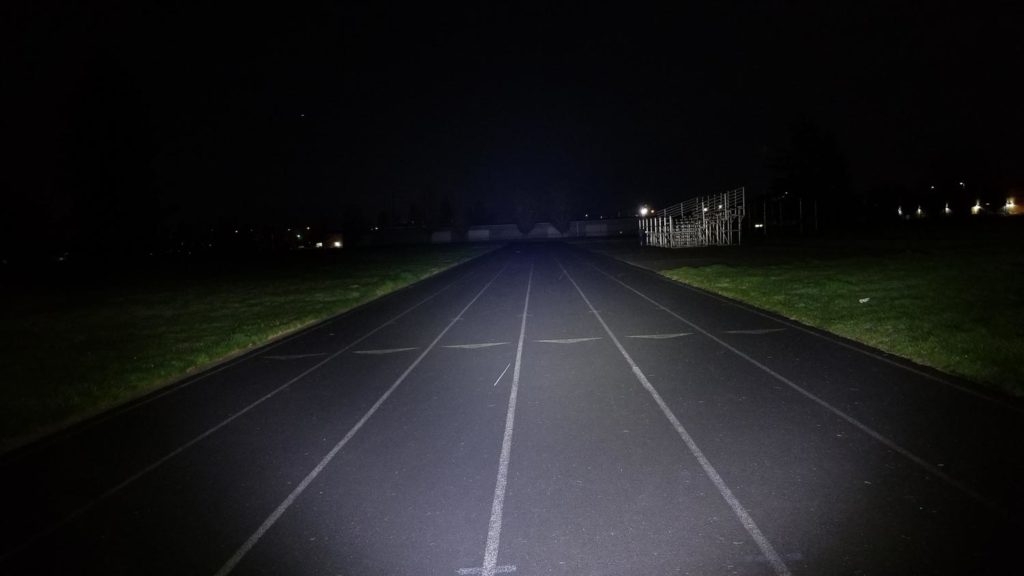





Disclaimer: This flashlight was sent to me for review at no cost by Imalent. I have not been paid to review, nor have I been holding back on problems or defects.
Final Verdict
Pros
- Awesome output
- Great warranty
- Small size
- Nice, useful beam
- Simple UI
- Good runtime and sustained output
Cons
- Greenish tint in low mode
- Gets pretty hot during prolonged use
- Included USB cable was DOA
- Switch button felt cheap
- No lanyard hole

4 stars: ★★★★
Once again Imalent has pushed the limits and proven what is possible in a small flashlight. I think the R30C has proven itself worthy to bear the Imalent name. 8000 lumens is pretty amazing for a light coming in under 5 inches long, and the sustained output and nicely regulated driver were also nice surprises. I really like that Imalent used the SST70 and not the XHP50.2 in this light. Much better beam, and more throw to boot. Now, there are some spoilers. The SST70 was a bit green in low mode, the cheap-feeling, hard to find switch was a disappointment. The non-functioning USB cable was a bummer, and no lanyard hole? Come on, Imalent. I’m not knocking it for the proprietary battery since it works great and has a warranty, but some might be put off by that. Bottom line, Imalent has created a useful, versatile, and extremely powerful light in a small form factor. Not perfect, but good enough for 4 stars.
Imalent R30C discount code
Use our exclusive discount coupon to get an extra 10% off. Use this code at checkout: 1LUMEN
1lumen selects and reviews products personally. We may earn affiliate commissions through our links, which help support our testing.